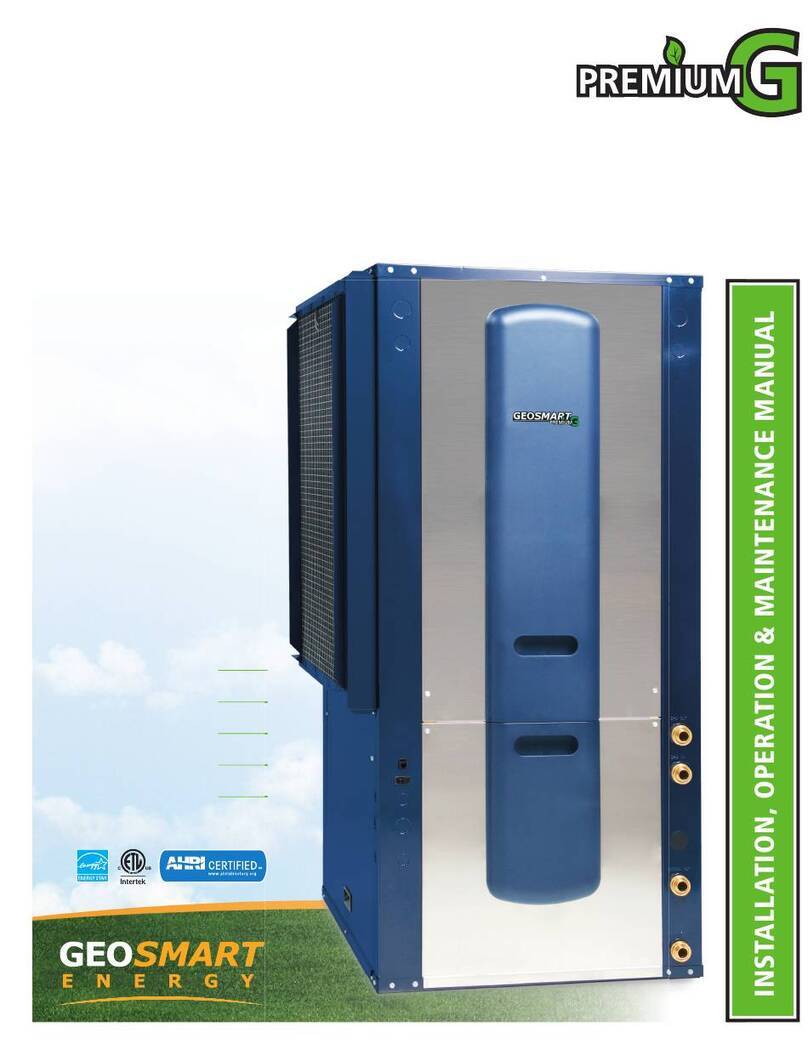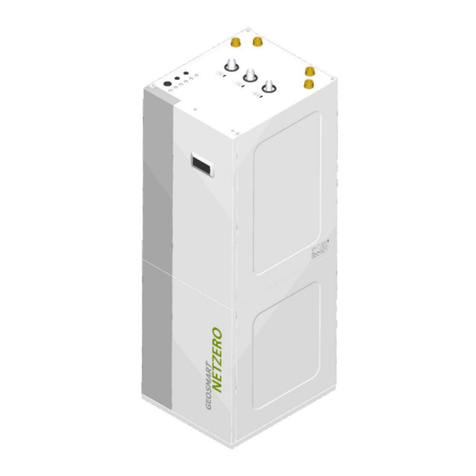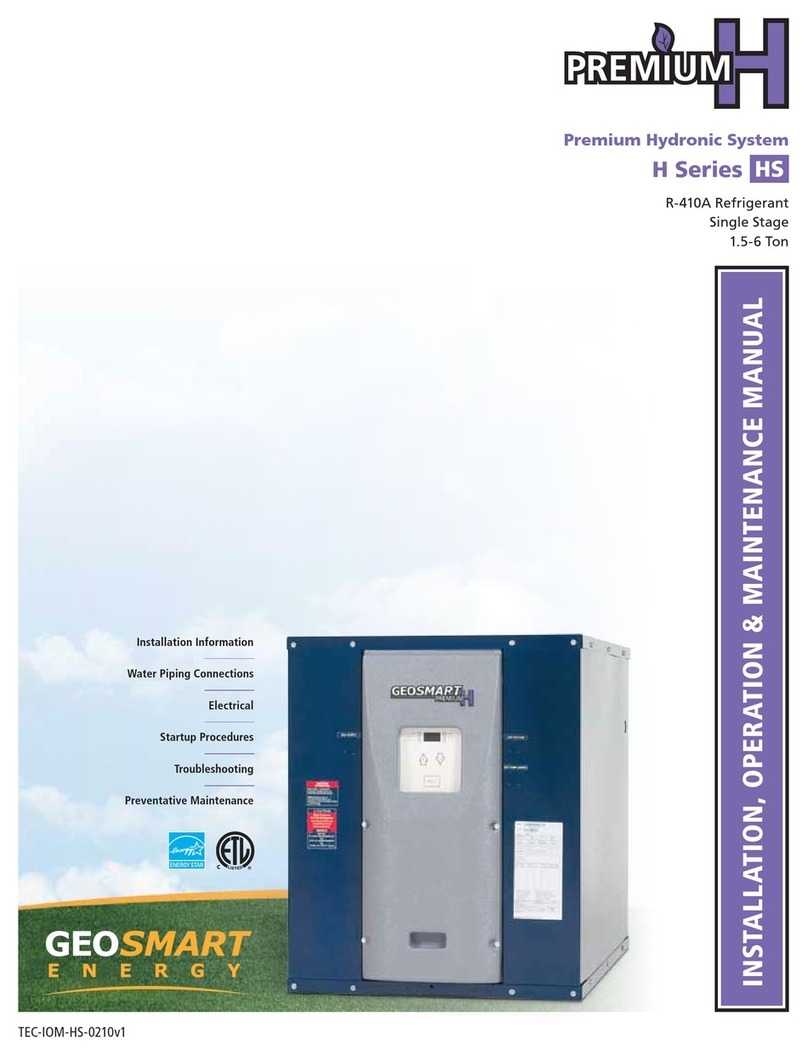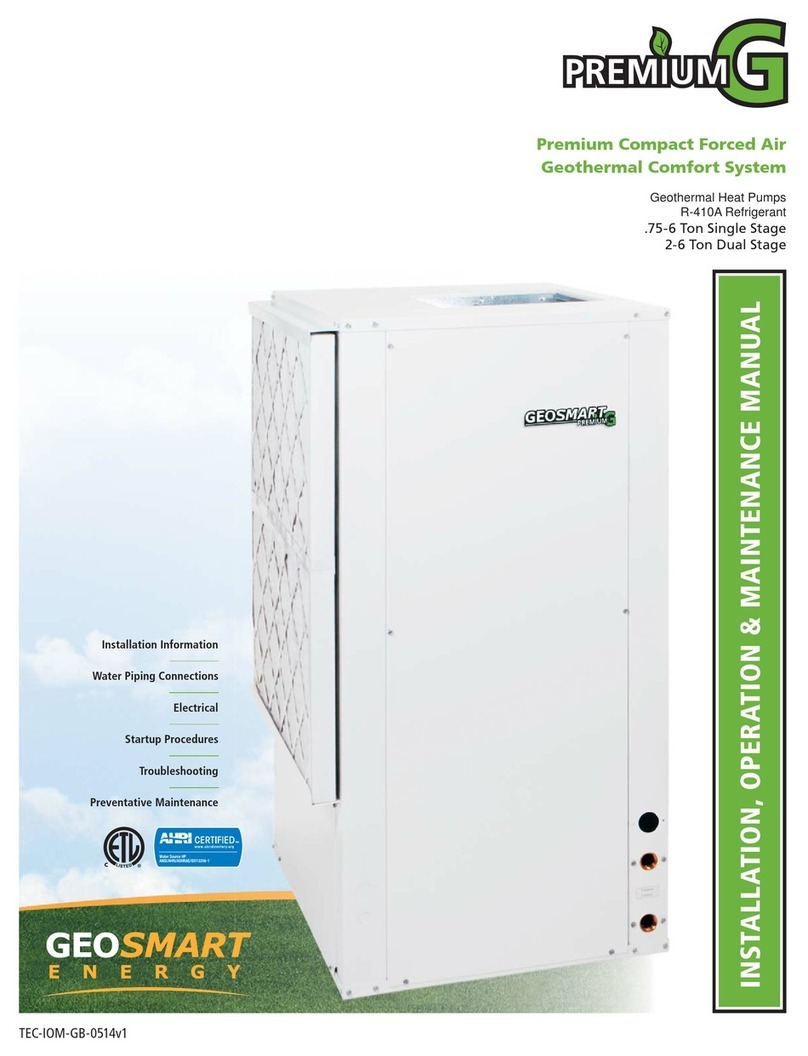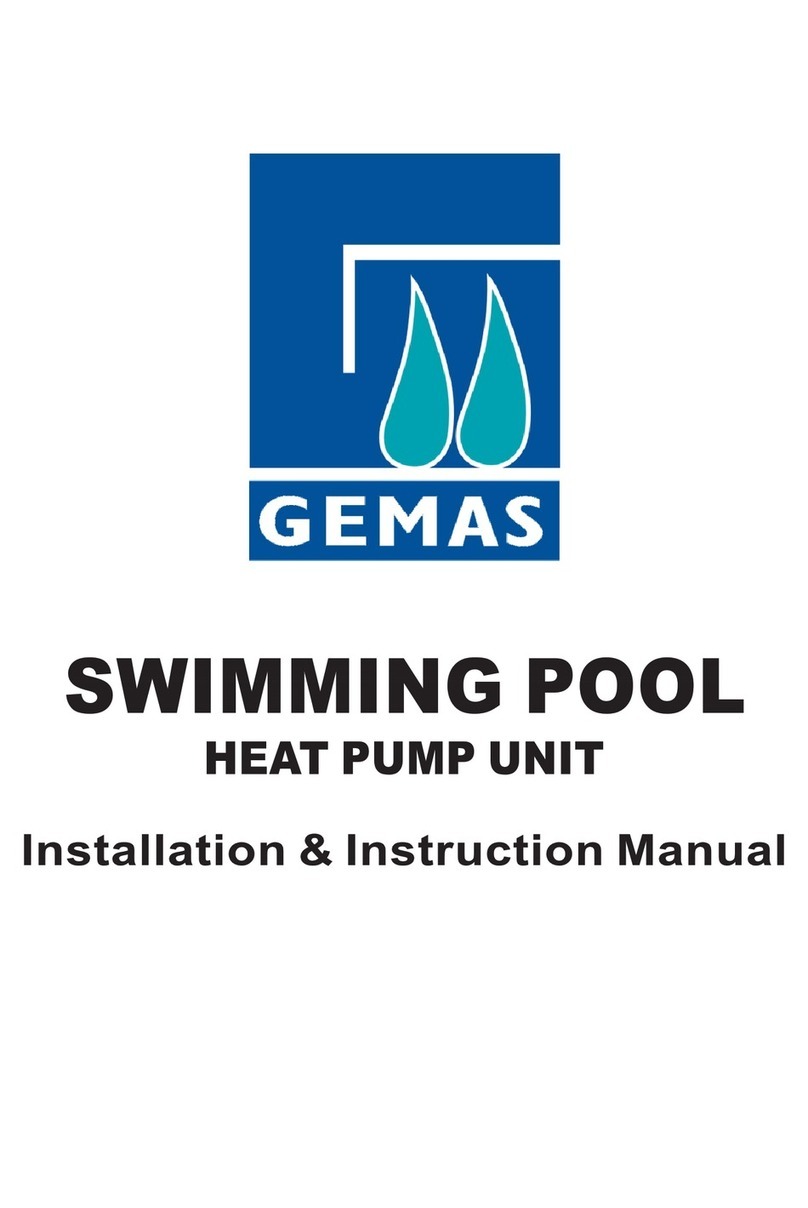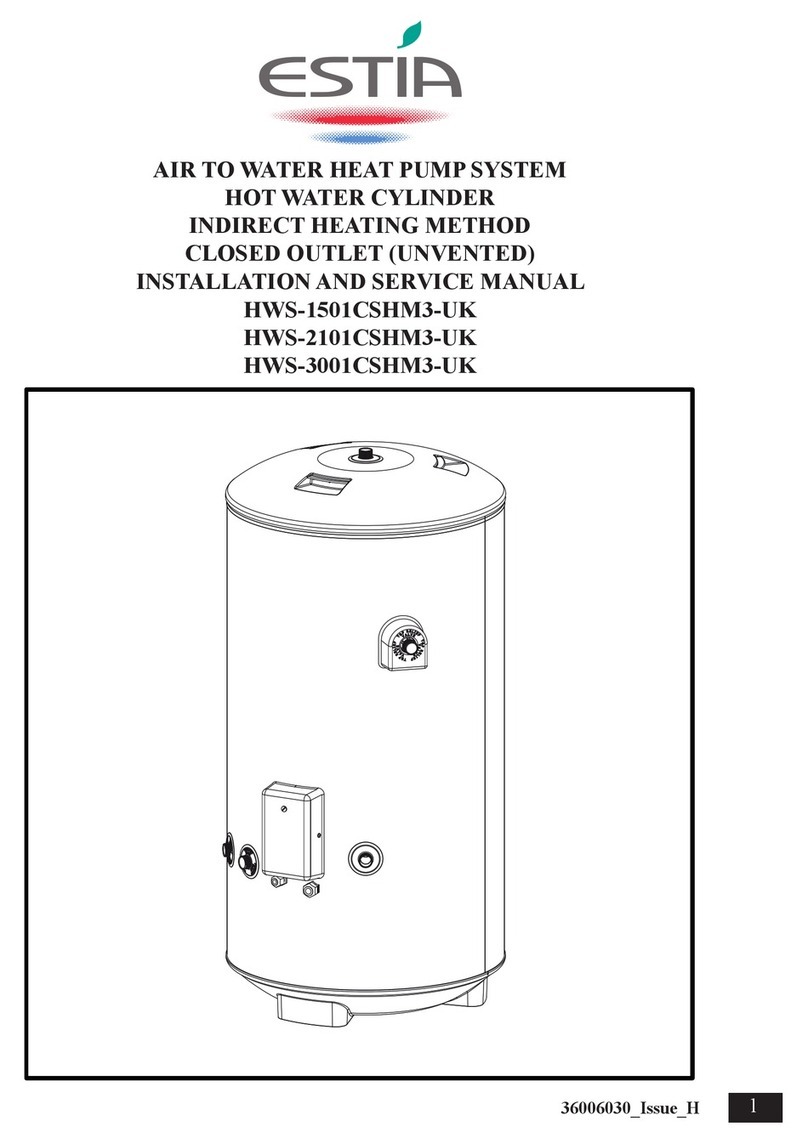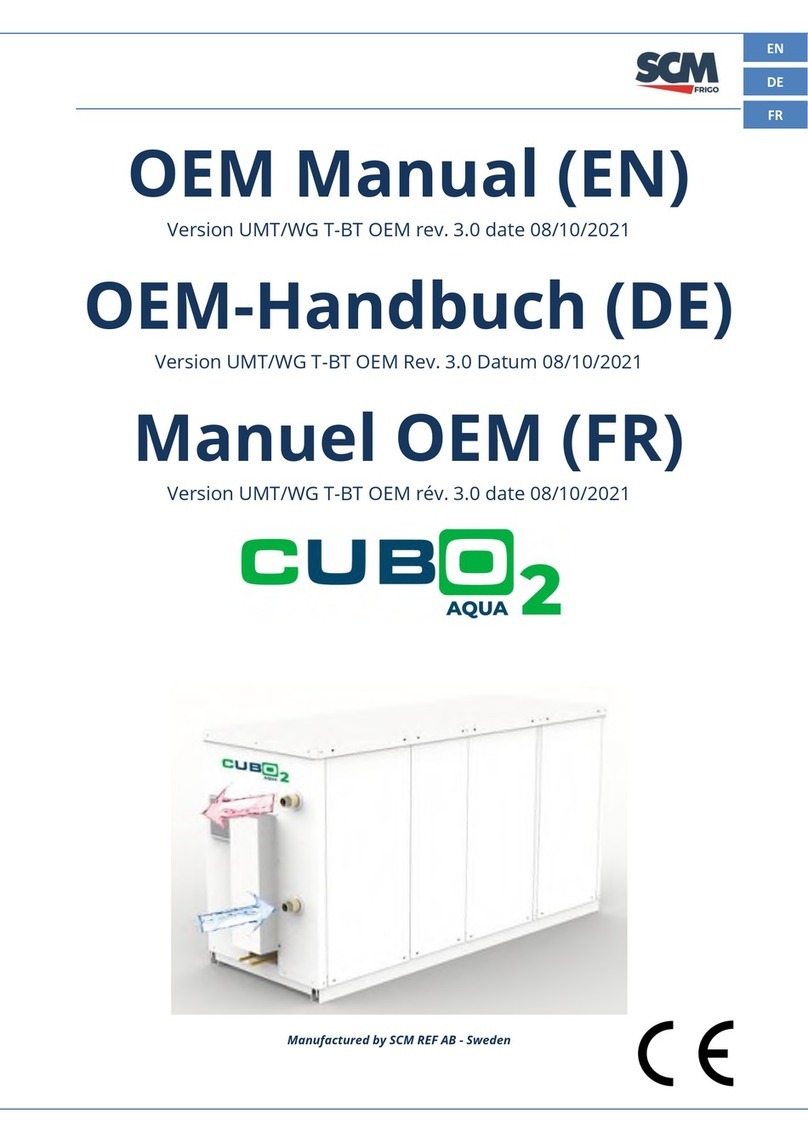GeoSmart ECO-Y User manual

TEC-IOM-Y-0310v1
InstallatIon, operatIon & MaIntenance Manual
Geothermal/ Water Source Heat Pump
R-410A Refrigerant
2- 6 Ton
Installation Information
Water Piping Connections
Hot Water Generator Connections
Electrical
Startup Procedures
Troubleshooting
Preventive Maintenance


ECO-Y INSTALLATION MANUAL
Table of Contents
Model Nomenclature ............................................................. 4
General Installation Information ...................................................5-8
Water Quality ................................................................... 9
Freeze Detection................................................................. 9
Condensate Drain............................................................... 10
Closed Loop Ground Source Systems.............................................. 10
Open Loop Ground Water Systems .................................................11
Hot Water Generator Connections ...............................................12-13
Electrical Connections........................................................... 14
Electronic Thermostat Installation . . . . . . . . . . . . . . . . . . . . . . . . . . . . . . . . . . . . . . . . . . . . . . . . . 14
Antifreeze Corrections........................................................... 15
Auxiliary Heat Ratings ........................................................... 15
Electrical Data.................................................................. 16
Blower Performance Data ......................................................17-18
X13 ECM Constant Torque Motors ................................................. 19
Vertical Dimensional Data . . . . . . . . . . . . . . . . . . . . . . . . . . . . . . . . . . . . . . . . . . . . . . . . . . . . . . 20-21
Horizontal Dimensional Data...................................................... 22
Physical Data .................................................................. 23
Wiring Schematics ............................................................24-27
Controls.....................................................................28-29
Unit Startup.................................................................... 30
Troubleshooting ................................................................ 31
Startup/Troubleshooting Form .................................................... 32
Operating Parameters ........................................................... 33
Operating Limits................................................................ 33
Quick Reference ................................................................ 34
Reference Calculations .......................................................... 35
Legends and Notes ............................................................. 35
Service Parts.................................................................36-37
Preventive Maintenance and Replacement Procedures................................ 38

4
ECO-Y INSTALLATION MANUAL
ECO-Y
Model Nomenclature
1-2
YS
3-5
024
6
T
7
L
8
1
9
0
10
0
11
C
12
B
13
C
14
S
15
S
16
A
Model Type
YS = Single Speed
Unit Capacity
024
030
036
042
048
060
070
Discharge Air Configuration
T = Top Discharge (vertical)
E = End (horizontal)
S = Side (horizontal)
Return Air Configuration
L = Left Painted
R = Right Painted
Voltage
1 = 208-230/60/1
Hot Water Options
0 = No Hot Water Generation, No GeoStart
1 = Hot Water Generation with factory
installed pump, No GeoStart
3 = No Hot Water Generation, GeoStart
4 = Hot Water Generation with factory
installed pump, GeoStart
Vintage
A = Current
Non-standard Option
S = Standard
Non-standard Option
S = Standard
Cabinet Option
C = Gray Cabinet
Sound Kit
B = Blanket
Coax Option
C = Copper
N = Cupronickel
Blower Option
0 = PSC
3 = Oversized PSC (024-030, 042-048 only)
4 = X13 ECM

5
ECO-Y INSTALLATION MANUAL
WARNING: Before performing service or maintenance
operations on a system, turn off main power switches
to the indoor unit. If applicable, turn off the accessory
heater power switch. Electrical shock could cause
personal injury.
Installing and servicing heating and air conditioning equipment can
be hazardous due to system pressure and electrical components.
Only trained and qualified service personnel should install, repair
or service heating and air conditioning equipment. Untrained
personnel can perform the basic maintenance functions of cleaning
coils and cleaning and replacing filters. All other operations should
be performed by trained service personnel. When working on
heating and air conditioning equipment, observe precautions in
the literature, tags and labels attached to the unit and other safety
precautions that may apply.
Follow all safety codes. Wear safety glasses and work gloves.
Use a quenching cloth for brazing operations and have a fire
extinguisher available.
Moving and Storage
Move units in the normal “up” orientation. Horizontal units may
be moved and stored per the information on the packaging. Do
not stack more than three units in total height. Vertical units may
be stored one upon another to a maximum height of two units.
Do not attempt to move units while stacked. When the equipment
is received, all items should be carefully checked against the bill
of lading to be sure all crates and cartons have been received.
Examine units for shipping damage, removing the units from the
packaging if necessary. Units in question should also be internally
inspected. If any damage is noted, the carrier should make
the proper notation on the delivery receipt, acknowledging the
damage.
Safety Considerations
General Installation Information
Unit Location
Locate the unit in an indoor area that allows for easy removal of
the filter and access panels. Location should have enough space
for service personnel to perform maintenance or repair. Provide
sufficient room to make water, electrical and duct connection(s). If
the unit is located in a confined space, such as a closet, provisions
must be made for return air to freely enter the space by means
of a louvered door, etc. Any access panel screws that would be
difficult to remove after the unit is installed should be removed
prior to setting the unit. On horizontal units, allow adequate room
below the unit for a condensate drain trap and do not locate the
unit above supply piping. Care should be taken when units are
located in unconditioned spaces to prevent damage from
frozen water lines and excessive heat that could damage
electrical components.
Installing Vertical Units
Prior to setting the unit in place, remove and discard the
compressor hold down shipping bolt located at the front of the
compressor mounting bracket.
Vertical units are available in left or right air return configurations.
Top air discharge vertical units should be mounted level on a
vibration absorbing pad slightly larger than the base to provide
isolation between the unit and the floor. It is not necessary to
anchor the unit to the floor.
Vertical Unit Mounting
2” Extruded
Polystyrene

6
ECO-Y INSTALLATION MANUAL
General Installation Information cont.
Installing Horizontal Units
Remove and discard the compressor hold down shipping bolt
located at the front of the compressor mounting bracket prior to
setting the unit in place. Horizontal units are available with side
or end discharge. Horizontal units are normally suspended from a
ceiling by four or six 3/8-inch diameter threaded rods. The rods are
usually attached to the unit by hanger bracket kits furnished with
each unit.
Lay out the threaded rods per the Hanger Dimensions table.
Assemble the hangers to the unit as shown on page 7. Securely
tighten the brackets to the unit using the weld nuts located on the
underside of the bottom panel. When attaching the hanger rods to
the bracket, a double nut is required since vibration could loosen
a single nut. To allow filter access, one bracket on the filter side
should be installed 180° from the position shown in the figure on
page 7. The unit should be pitched approximately 1/4-inch towards
the drain in both directions to facilitate the removal of condensate.
Use only the bolts provided in the kit to attach hanger brackets.
The use of longer bolts could damage internal parts.
Insulate supply
plenum and use
at least one 90
elbow to
reduce noise
Electrical
Disconnect
Flexible Duct
Collar
Threaded Rods
Line Voltage
Ball Valves
Hose
Kits
To Line
Power
To
Thermostat
Hanging
Brackets
(Included)
Building Water Loop
O
Horizontal Unit Mounting
Some residential applications require the installation of horizontal
units on an attic floor. In this case, the unit should be set in a full
size secondary drain pan on top of a vibration absorbing pad. The
secondary drain pan prevents possible condensate overflow or
water leakage damage to the ceiling. The secondary drain pan is
usually placed on a plywood base isolated from the ceiling joists by
additional layers of vibration absorbing material.
CAUTION: Do not use rods smaller than 3/8-inch
diameter since they may not be strong enough
to support the unit. The rods must be securely
anchored to the ceiling.

7
ECO-Y INSTALLATION MANUAL
Corner Weight Locations
General Installation Information cont.
Model Horizontal Corner Weights
Post #1 Post #2 Post #3 Post #4 Total
024 lb 35 119 81 33 268
kg [16] [54] [37] [15] [122]
030 lb 38 122 86 33 279
kg [17] [55] [39] [15] [127]
036 lb 40 124 88 35 287
kg [18] [56] [40] [16] [130]
042 lb 63 147 87 52 349
kg [29] [67] [39] [24] [158]
048 lb 64 152 89 53 358
kg [29] [69] [40] [24] [162]
060 lb 93 156 81 73 403
kg [42] [71] [37] [33] [183]
070 lb 143 137 124 34 438
kg [65] [62] [56] [15] [199]
10/28/09
Corner 1
Corner 2
Corner 3
Corner 4
Horizontal
Models
Unit Hanger Dimensions
A B C D
024-036 in. 21.1 63.4 24.8 -
cm. 53.6 161.0 63.0 -
042-048 in. 24.1 43.1 27.8 29.3
cm. 61.2 109.5 70.6 74.4
060 in. 24.1 48.1 27.8 29.3
cm. 61.2 122.2 70.6 74.4
070 in. 24.1 53.1 27.8 29.3
cm. 61.2 134.9 70.6 74.4
Unit Hanger Detail
YSH024 - YSH036
Unit Hanger Detail
YSH042 - YSH070
A
B
C
D
B
AC
Vibration Isolator
Washer
Hex Nuts
(not supplied)
Bolt and
Lockwasher
3/8”
Threaded Rod
(not supplied)
Unit Hanger Dimensions

8
ECO-Y INSTALLATION MANUAL
Duct System
An air outlet collar is provided on vertical top air discharge units
and all horizontal units to facilitate a duct connection. A flexible
connector is recommended for discharge and return air duct
connections on metal duct systems. Uninsulated duct should be
insulated with a minimum of 1-inch duct insulation. Application of
the unit to uninsulated ductwork in an unconditioned space is not
recommended as the unit’s performance will be adversely affected.
If the unit is connected to existing ductwork, check the duct
system to ensure that it has the capacity to accommodate the air
required for the unit application. If the duct is too small, as in the
replacement of heating only systems, larger ductwork should be
installed. All existing ductwork should be checked for leaks and
repaired if necessary.
The duct system should be sized to handle the design airflow
quietly and efficiently. To maximize sound attenuation of the unit
blower, the supply and return plenums should include an internal
duct liner of fiberglass or constructed of ductboard for the first few
feet. On systems employing a sheet metal duct system, canvas
connectors should be used between the unit and the ductwork. If
air noise or excessive airflow is a problem, the blower speed can
be changed.
Water Piping
The proper water flow must be provided to each unit whenever the
unit operates. To assure proper flow, use pressure/temperature
ports to determine the flow rate. These ports should be located at
the supply and return water connections on the unit. The proper
flow rate cannot be accurately set without measuring the water
pressure drop through the refrigerant-to-water heat exchanger.
All source water connections on residential units are swivel piping
fittings (see Swivel Connections figure) that accept a 1-inch male
pipe thread (MPT). The swivel connector has a rubber gasket seal
similar to a rubber hose gasket, which when mated to the flush
end of any 1-inch threaded pipe provides a leak-free seal without
the need for thread sealing tape or compound. Check to ensure
that the rubber seal is in the swivel connector prior to attempting
any connection. The rubber seals are shipped attached to the
waterline. To make the connection to a ground loop system, mate
the brass connector (supplied in CK4L connector kit) against
the rubber gasket in the swivel connector and thread the female
locking ring onto the pipe threads, while maintaining the brass
connector in the desired direction. Tighten the connectors by hand,
then gently snug the fitting with pliers to provide a leak-proof joint.
When connecting to an open loop (ground water) system, thread
any 1-inch MPT fitting (SCH80 PVC or copper) into the swivel
Swivel Connections
Locking
Ring
Stainless
Steel
Snap Ring
Gasket
Support
Sleeve
Gasket
Material
CAUTION: Be sure to remove the shipping material
from the blower discharge before connecting
ductwork.
General Installation Information cont.
connector and tighten in the same manner as noted above. The
open and closed loop piping system should include pressure/
temperature taps for serviceability.
Never use flexible hoses smaller than 1-inch inside diameter
on the unit. Limit hose length to 10 feet per connection. Check
carefully for water leaks.

9
ECO-Y INSTALLATION MANUAL
In ground water situations where scaling could be heavy or where
biological growth such as iron bacteria will be present, a closed
loop system is recommended. The heat exchanger coils in ground
water systems may, over a period of time, lose heat exchange
capabilities due to a buildup of mineral deposits inside. These
can be cleaned, but only by a qualified service mechanic, as
special solutions and pumping equipment are required. Hot water
generator coils can likewise become scaled and possibly plugged.
Water Quality
Material Copper 90/10 Cupro-Nickel 316 Stainless Steel
pH Acidity/Alkalinity 7- 9 7 - 9 7 - 9
Scaling Calcium and Magnesium Carbonate (Total Hardness) less than 350 ppm (Total Hardness) less than 350 ppm (Total Hardness) less than 350 ppm
Hydrogen Sulfide Less than .5 ppm (rotten egg smell
appears at 0.5 PPM) 10 - 50 ppm Less than 1 ppm
Sulfates Less than 125 ppm Less than 125 ppm Less than 200 ppm
Chlorine Less than .5 ppm Less than .5 ppm Less than .5 ppm
Chlorides Less than 20 ppm Less than125 ppm Less than 300 ppm
Carbon Dioxide Less than 50 ppm 10 - 50 ppm 10- 50 ppm
Ammonia Less than 2 ppm Less than 2 ppm Less than 20 ppm
Ammonia Chloride Less than .5 ppm Less than .5 ppm Less than .5 ppm
Ammonia Nitrate Less than .5 ppm Less than .5 ppm Less than .5 ppm
Ammonia Hydroxide Less than .5 ppm Less than .5 ppm Less than .5 ppm
Ammonia Sulfate Less than .5 ppm Less than .5 ppm Less than .5 ppm
Total Dissolved Solids (TDS) Less than 1000 ppm 1000-1500 ppm 1000-1500 ppm
LSI Index +0.5 to -.05 +0.5 to -.05
Iron, Fe2+ (Ferrous)
Bacterial Iron Potential < .2 ppm < .2 ppm < .2 ppm
Iron Oxide Less than 1 ppm. Above this level
deposition will occur.
Less than 1 ppm. Above this level
deposition will occur.
Less than 1 ppm. Above this level
deposition will occur.
Suspended Solids Less than 10 ppm and filtered for max of
600 micron size
Less than 10 ppm and filtered for max of
600 micron size
Less than 10 ppm and filtered for max of
600 micron size
Threshold Velocity (Fresh Water) < 6 ft/sec < 6 ft/sec < 6 ft/sec
Grains = PPM divided by 17 • mg/l is equivalent to PPM 2/8/08
Corrosion
Erosion
Iron Fouling
(Biological Growth)
+0.5 to -.05
In areas with extremely hard water, the owner should be informed
that the heat exchanger may require occasional flushing.
Units with cupronickel heat exchangers are recommended for
open loop applications due to the increased resistance to build-up
and corrosion, along with reduced wear caused by acid cleaning.
Set SW1-2 on the printed circuit board for applications using a
closed loop antifreeze solution to “LOOP” (15°F) [-9.4°C]. On
applications using an open loop/ground water system (or closed
loop no antifreeze), set this dip switch to “WELL” (30°F) [-1.1°C],
the factory default setting. (Refer to the Dip Switch Field Selection
table).
Freeze Detection

10
ECO-Y INSTALLATION MANUAL
1/2'' Pitch
Drain
Unit Pitch for DrainHorizontal Drain Connection (Composite Drain Pan)
Condensate Drain
On vertical units, the internal condensate drain assembly consists
of a drain tube which is connected to the drain pan, a 3/4 in. PVC
female adapter and a flexible connecting hose. The female adapter
may exit either the front or the side of the cabinet. The adapter
should be glued to the field-installed PVC condensate piping.
On vertical units, a condensate hose is inside all cabinets as a
trapping loop; therefore, an external trap is not necessary.
On horizontal units, a PVC stub is provided for condensate drain
piping connection. An external trap is required (see below). If a
vent is necessary, an open stand pipe may be applied to a tee in
the field-installed condensate piping.
1.5" 1.5"
3/4” PVC tube stub
3/4" PVC
Coupling
Vent (if needed)
3/4" PVC
1/8" per foot
NOTE: For closed loop systems with antifreeze protection, set
SW1-2 to the “loop” position.
Once piping is completed between the unit, pumps and the ground
loop, final purging and charging of the loop is required. A flush
cart (or a 1.5 HP pump minimum) is needed to achieve adequate
flow velocity in the loop to purge air and dirt particles from the
loop itself. Antifreeze solution is used in most areas to prevent
freezing. Flush the system adequately to remove as much air as
possible then pressurize the loop to a static pressure of 40-50
PSI (summer) or 50-75 PSI (winter). This is normally adequate
for good system operation. Loop static pressure will fluctuate with
the seasons. Pressures will be higher in the winter months than
during the cooling season. This fluctuation is normal and should be
considered when initially charging the system.
After pressurization, be sure to turn the venting (burping) screw in
the center of the pump two (2) turns open (water will drip out), wait
until all air is purged from the pump, then tighten the plug. Ensure
that the loop pumps provide adequate flow through the unit(s)
by checking the pressure drop across the heat exchanger and
comparing it to the unit capacity data in the specification catalog.
2.5 to 3 GPM of flow per ton of cooling capacity is recommended in
earth loop applications.
Closed Loop Ground Source Systems
Closed Loop Ground Source Application
Flexible Duct
Collar
Vibration Absorbing Pad
P/T Plugs
Drain
Hot Water Generator
Connections
Auxiliary
Heater
Knockout
Low
Voltage to
Thermostat
Unit Supply
Auxiliary Heat
Supply
Insulated piping
or hose kit
Disconnects
(If Applicable)
Unit Power
P/T
TO
LOOP
GeoLink
®
Flow
Center
GeoLink®
Polyethylene w/
Armaflex®
Insulation
NOTE: Additional information can be found in Flow Center
installation manual and Flush Cart manual.

11
ECO-Y INSTALLATION MANUAL
Typical open loop piping is shown below. Always maintain water
pressure in the heat exchanger by placing water control valves at
the outlet of the unit to prevent mineral precipitation. Use a closed,
bladder-type expansion tank to minimize mineral formation due to
air exposure. Insure proper water flow through the unit by checking
pressure drop across the heat exchanger and comparing it to the
figures in unit capacity data tables in the specification catalog. 1.5-
2 GPM of flow per ton of cooling capacity is recommended in open
loop applications.
Flexible
Duct Collar
Vibration
Absorbing Pad
P/T Plugs
Drain
Hot Water Generator
Connections
Auxiliary
Heater
Knockout
Low Voltage
to Thermostat
and Valve
Unit Supply
Aux. Heat Supply
Water Out
Water In
Shut Off Valves
Boiler Drains
For HX Flushing
Disconnects
(IfApplicable)
Rubber Bladder
Expansion Tank
Solenoid
Valve
Shut Off Valves
(to isolate solenoid
valve while acid flushing)
Strainer
Flow Control
Valve
(on outlet of
Solenoid Valve)
Compressor
Line Voltage
Open System - Groundwater Application
Open Loop Ground Water Systems
Discharge water from the unit is not contaminated in any manner
and can be disposed of in various ways, depending on local codes,
i.e. recharge well, storm sewer, drain field, adjacent stream or
pond, etc. Most local codes forbid the use of sanitary sewer for
disposal. Consult your local building and zoning departments to
assure compliance in your area.
NOTE: For open loop/groundwater systems or systems that do not
contain an antifreeze solution, set SW1-Switch #2 to the “WELL”
position. Slow opening/closing solenoid valves (type VM) are
recommended to eliminate water hammer.
CC-GND
CC
Logic Board
VM valve
Violet
CC
Violet
CC-GND
CC
Logic Board
Violet
CC
SV
Violet
Open Loop Solenoid Valve Connection Option
Typical slow operating external 24V water solenoid valve
(type VM) wiring and one (1) quick operating valve.
Open Loop Solenoid Valve Connection Option
Typical quick operating external 24V water solenoid valve
(type PPV100 or BPV100) wiring.
CC-GND
CC
Logic Board
VM valve
Violet
CC
Violet
CC-GND
CC
Logic Board
Violet
CC
SV
Violet

12
ECO-Y INSTALLATION MANUAL
To maximize the benefits of the hot water generator a minimum
50-gallon water heater is recommended For higher demand
applications, use an 80-gallon water heater or two 50-gallon
water heaters connected in a series as shown below. Electric
water heaters are recommended. Make sure all local electrical
and plumbing codes are met for installing a hot water generator.
Residential units with hot water generators contain an internal
circulator and fittings. A water softener is recommended with hard
water (greater than 10 grains or 170 total hardness). Once air has
been purged from the water piping circuit, connect the blue wire
from the hot water generator pump to T1 on the contactor (unit
ships with this wire disconnected). The hot water generator pump
will not operate until this wire is connected to the contactor.
Typical Hot Water Generator Installation
CAUTION: Elements will burn out if energized dry.
Hot Water Generator Installation In Preheat Tank
In
Ball Valve
3/4" x 3/4" x 1/2"
tee
Cold
Water In
Hot
Water Out
P/T Relief
Valve
P/T Relief
Valve
DHW
Water In
DHW
Water Out
Drain ValveDrain Valve
Vent
NOTE: This configuration maximizes hot water generator
capability.
Drain Valve
In
P/T Relief
Valve
Cold
Water In Hot
Water Out
DHW
Water In
DHW
Water Out
Ball Valve
3/4 x 3/4 x 1/2 tee
Vent
Hot Water Generator Connections
Water Tank Preparation
To install a unit with a hot water generator, follow these installation
guidelines.
1. Turn off the power to the water heater.
2. Attach a water hose to the water tank drain connection and run
the other end of the hose to an open drain or outdoors.
3. Close the cold water inlet valve to the water heater tank.
4. Drain the tank by opening the valve on the bottom of the tank,
then open the pressure relief valve or hot water faucet.
5. Flush the tank by opening the cold water inlet valve to the water
heater to free the tank of sediments. Close when draining water
is clear.
6. Disconnect the garden hose and remove the drain valve from
the water heater.
7. Refer to Plumbing Installation and Hot Water Generator Startup.

13
ECO-Y INSTALLATION MANUAL
Plumbing Installation
1. Inspect the dip tube in the water heater cold inlet for a check
valve. If a check valve is present it must be removed or
damage to the hot water generator circulator will occur.
2. Remove drain valve and fitting.
3. Thread the 3/4 in. NPT x 3-1/2 in. brass nipple into the water
heater drain port.
4. Attach the center port of the 3/4 in. FPT tee to the opposite end
of the brass nipple.
5. Attach the 1/2 in. copper to 3/4 in. NPT adaptor to the side of
the tee closest to the unit.
6. Install the drain valve on the tee opposite the adaptor.
7. Run interconnecting tubing from the tee to HWG water out.
8. Cut the cold water “IN” line going to the water heater.
9. Insert the reducing solder tee in line with cold water “IN” line as
shown.
10. Run interconnecting copper tubing between the unit HWG
water “IN” and the tee (1/2 in. nominal). The recommended
maximum distance is 50 ft.
11. To prevent air entrapment in the system, install a vent coupling
at the highest point of the interconnecting lines.
12. Insulate all exposed surfaces of both connecting water lines
with 3/8 in. wall closed cell insulation.
NOTE: All plumbing and piping connections must comply with local
plumbing codes.
CAUTION: Never operate the HWG circulating pump
while dry. If the unit is placed in operation before
the hot water generator piping is connected, be
sure that the pump wires are disconnected from the
contactor.
Hot Water Generator Connections cont.
Hot Water Generator Startup
1. Make sure the power is off to the heat pump. Connect the blue
wire from the hot water generator pump to T1 on the contactor
(unit ships with this wire disconnected). The hot water
generator pump will not operate until this wire is connected to
the contactor.
2. Close the drain valve to the water heater.
3. Open the cold water supply to the tank.
4. Open a hot water faucet in the building to bleed air from the
system. Close when full.
5. Open the pressure relief valve to bleed any remaining air from
the tank, then close.
6. If so equipped, turn the venting (burping) screw in the center
of the pump two (2) turns open (water will drip out), wait until
all air is purged from the pump, then tighten the plug. Use vent
couplings to bleed air from the lines.
7. Carefully inspect all plumbing for water leaks and correct as
required.
8. Before restoring electrical supply to the water heater, adjust the
temperature setting on the tank.
• On tanks with both upper and lower elements, the lower
element should be turned down to the lowest setting,
approximately 100°F. The upper element should be
adjusted to 120°F to 130°F. Depending upon the specific
needs of the customer, you may want to adjust the upper
element differently.
• On tanks with a single element, lower the thermostat
setting to 120°F.
9. After the thermostat(s) is adjusted, replace the access cover
and restore electrical supply to the water heater.
10. Make sure that any valves in the hot water generator circuit are
open.
11. Turn on the unit to heating.
12. The HWG pump should be running. When the pump is first
started, turn the venting (burping) screw (if equipped) in the
center of the pump two (2) turns open until water dribbles out,
then replace. Allow the pump to run for at least five minutes to
ensure that water has filled the circulator properly.
13. The temperature difference between the water entering
and leaving the hot water generator should be 5°F to 15°F.
The water flow should be approximately 0.4 GPM per ton of
nominal cooling.
14. Allow the unit to heat water for 15 to 20 minutes to be sure
operation is normal.

14
ECO-Y INSTALLATION MANUAL
CC
PS
312
TB
General
Be sure the available power is the same voltage and phase as that
shown on the unit serial plate. Line and low voltage wiring must be
done in accordance with local codes or the National Electric Code,
whichever is applicable.
Unit Power Connection
Connect the incoming line voltage wires to L1 and L2 of the
contactor as shown below for single-phase unit. Consult the unit’s
Electrical Data for correct fuse sizes.
Open lower front access panel. Insert power wires through
knockouts on lower left side of cabinet. Route wires through left
side of control box and connect to contactor and ground. Close
lower front access panel before unit start-up.
Line Voltage 208-230/60/1 Control Box
Electrical Connections
Pump Wiring 208-230/60/1
Position the thermostat subbase against the wall so that it is
level and the thermostat wires protrude through the middle of the
subbase. Mark the position of the subbase mounting holes and
drill holes with a 3/16-inch bit. Install supplied anchors and secure
base to the wall. Thermostat wire must be 8-conductor, 18-AWG
wire. Strip the wires back 1/4-inch (longer strip lengths may cause
shorts) and insert the thermostat wires into the connector as
shown. Tighten the screws to insure secure connections. The
thermostat has the same type connectors, requiring the same
wiring. See instructions enclosed in the thermostat for detailed
installation and operation information.
Electronic Thermostat Installation
208 Volt Operation
All ECO-Y 208/230 units are factory wired for 230 volt operation.
For 208 volt operation, the red and blue transformer wires must be
switched on terminal strip PS.
Pump Wiring
See Pump Wiring figure below for electrical connections
from control box to pumps.
R
Y1
C
O
G
L
W
24VAC (Hot)
24VAC (Common)
Compressor
Reversing Valve
Blower Relay
System Monitor
Aux. Heat
Terminal Block (TB)
Thermostat
R
C
Y1
O
G
L
W1
Thermostat Wiring
CC
PS
312
TB
Loop Pump
Power
Thermostat
Connections
L2 L1
Line Voltage
Ground Ground

15
ECO-Y INSTALLATION MANUAL
Antifreeze Corrections
Catalog performance can be corrected for antifreeze use. Please
use the following table and note the example given.
Antifreeze Correction Example
Antifreeze solution is Propylene Glycol 20% by weight. Determine
the corrected heating and cooling performance at 30°F and 90°F
respectively as well as pressure drop at 30°F for a YS024-PSC.
The corrected cooling capacity at 90°F would be:
24,500 MBtuh x 0.969 = 23,741 MBtuh
The corrected heating capacity at 30°F would be:
19,000 MBtuh x 0.913 = 17,347 MBtuh
The corrected pressure drop at 30°F and 6 GPM would be:
10.5 feet of head x 1.270 = 13.34 feet of head
Antifreeze Type Antifreeze
% by wt
Cooling
Capacity
Heating
Capacity Pressure Drop
EWT - degF [DegC] 90 [32.2] 30 [-1.1] 30 [-1.1]
Water 0 1.000 1.000 1.000
10 0.991 0.973 1.075
20 0.979 0.943 1.163
Ethylene Glycol 30 0.965 0.917 1.225
40 0.955 0.890 1.324
50 0.943 0.865 1.419
10 0.981 0.958 1.130
20 0.969 0.913 1.270
Propylene Glycol 30 0.950 0.854 1.433
40 0.937 0.813 1.614
50 0.922 0.770 1.816
10 0.991 0.927 1.242
20 0.972 0.887 1.343
Ethanol 30 0.947 0.856 1.383
40 0.930 0.815 1.523
50 0.911 0.779 1.639
10 0.986 0.957 1.127
20 0.970 0.924 1.197
Methanol 30 0.951 0.895 1.235
40 0.936 0.863 1.323
50 0.920 0.833 1.399
Warning: Gray area represents antifreeze concentrations greater than 35% by weight and
should be avoided due to the extreme performance penalty they represent.
Auxiliary Heat Ratings
Model KW BTU/HR Min ECO-Y Compatibility
208V 230V Stages 208V 230V CFM 024 - 036 042 048 - 070
EAM(H)5 3.6 4.8 1 12,300 16,300 450 •
EAM(H)8 5.7 7.6 1 19,400 25,900 550 •
EAM(H)10 7.2 9.6 1 24,600 32,700 650 •
EAL(H)10 7.2 9.6 1 24,600 32,700 1100 • •
EAL(H)15 10.8 14.4 1 36,900 49,100 1250 • •
EAL(H)20 14.4 19.2 1 49,200 65,500 1500 •
9/18/09
Model Supply
Circuit
Heater Amps Min Circuit Amp Max Fuse (USA) Max Fuse (CAN) Max CKT BRK
208 V 240 V 208 V 240 V 208 V 240 V 208 V 240 V 208 V 240 V
EAM(H)5 Single 17.3 20 26.7 30 30 30 30 30 30 30
EAM(H)8 Single 27.5 31.7 39.3 44.6 40 45 40 45 40 50
EAM(H)10 Single 34.7 40 48.3 55 50 60 50 60 50 60
EAL(H)10 Single 34.7 40 53.3 60 60 60 60 60 60 60
EAL(H)15
Single 52.0 60 75 85 80 90 80 90 70 100
L1/L2 34.7 40 53.3 60 60 60 60 60 60 60
L3/L4 17.3 20 21.7 25 25 25 25 25 20 30
EAL(H)20
Single 69.3 80 96.7 110 100 110 100 110 100 100
L1/L2 34.7 40 53.3 60 60 60 60 60 60 60
L3/L4 34.7 40 43.3 50 45 50 45 50 40 50
9/18/09
All heaters rated single phase 60 cycle and include unit blower load.
All fuses type “D” time delay (or HACR circuit breaker in USA)
Wire length based on one-way measurement with 2% voltage drop
Wire size based on 60°C (*90°C) copper conductor
“H” is used in part numbers for horizontal units

16
ECO-Y INSTALLATION MANUAL
Electrical Data
X13 ECM Motor
Model Compressor
Model No.
Rated
Voltage
Voltage
Min/Max
Compressor HWG
Pump
FLA
Ext
Loop
FLA
Blower
Motor
FLA
Total
Unit
FLA
Min
Circ
Amp
Max
Fuse/
HACR
MCC RLA LRA LRA**
024 ZP20K5E-PFV 208-230/60/1 197/253 21.0 13.5 58.3 21.0 0.4 5.4 4.1 23.4 26.8 40
030 ZP25K5E-PFV 208-230/60/1 197/253 22.0 14.1 73.0 26.0 0.4 5.4 4.1 24.0 27.5 40
036 HRH029U1LP6 208-230/60/1 197/253 27.0 17.3 96.7 34.0 0.4 5.4 4.1 27.2 31.5 45
042 HRH034U1LP6 208-230/60/1 197/253 31.0 20.0 115.0 41.0 0.4 5.4 7.6 33.4 38.4 50
048 HRH040U1LP6 208-230/60/1 197/253 32.0 21.0 115.0 41.0 0.4 5.4 7.6 34.4 39.7 60
060 HRH051U1LP6 208-230/60/1 197/253 41.0 26.3 150.0 53.0 0.4 5.4 7.6 39.7 46.3 70
070 HRH056U1LP6 208-230/60/1 197/253 47.0 30.1 145.0 51.0 0.4 5.4 7.6 43.5 51.0 80
10/20/09
HACR circuit breaker in USA only
** With optional GeoStartTM, only available on 208-230/60/1
PSC Motor
Model Compressor
Model No.
Rated
Voltage
Voltage
Min/Max
Compressor HWG
Pump
FLA
Ext
Loop
FLA
Blower
Motor
FLA
Total
Unit
FLA
Min
Circ
Amp
Max
Fuse/
HACR
MCC RLA LRA LRA**
024 ZP20K5E-PFV 208-230/60/1 187/253 21.0 13.5 58.3 21.0 0.4 5.4 1.2 20.5 23.9 35
024* ZP20K5E-PFV 208-230/60/1 187/253 21.0 13.5 58.3 21.0 0.4 5.4 1.5 20.8 24.2 35
030 ZP25K5E-PFV 208-230/60/1 187/253 22.0 14.1 73.0 26.0 0.4 5.4 1.5 21.4 24.9 35
030* ZP25K5E-PFV 208-230/60/1 187/253 22.0 14.1 73.0 26.0 0.4 5.4 2.2 22.1 25.6 35
036 HRH029U1LP6 208-230/60/1 187/253 27.0 17.3 96.7 34.0 0.4 5.4 2.2 25.3 29.6 45
042 HRH034U1LP6 208-230/60/1 187/253 31.0 20.0 115.0 41.0 0.4 5.4 3.5 29.3 34.3 50
042* HRH034U1LP6 208-230/60/1 187/253 31.0 20.0 115.0 41.0 0.4 5.4 4.6 30.4 35.4 50
048 HRH040U1LP6 208-230/60/1 187/253 32.0 21.0 115.0 41.0 0.4 5.4 3.5 30.3 35.6 50
048* HRH040U1LP6 208-230/60/1 187/253 32.0 21.0 115.0 41.0 0.4 5.4 4.6 31.4 36.7 50
060 HRH051U1LP6 208-230/60/1 187/253 41.0 26.3 150.0 53.0 0.4 5.4 5.9 38.0 44.6 70
070 HRH056U1LP6 208-230/60/1 187/253 47.0 30.1 145.0 51.0 0.4 5.4 5.9 41.8 49.3 70
01/11/10
HACR circuit breaker in USA only
*With optional High-static PSC motor
** With optional GeoStart, only available on 208-230/60/1
High-static option not available on 036, 060, & 070 model sizes.

17
ECO-Y INSTALLATION MANUAL
Setting Blower Speed - PSC
CAUTION: Disconnect all power before performing
this operation.
Blower Performance Data - PSC
PSC FAN MOTOR BODY
HIGH LOWMEDIUM
F
A
N
S
P
E
E
D
W
I
R
E
Standard PSC Motor
Optional High Static PSC Motor
Factory settings are in Bold
Air flow values are with dry coil and standard filter
For wet coil performance first calculate the face velocity of the air coil (Face Velocity [fpm] = Airflow [cfm] / Face Area [sq ft]).
Then for velocities of 200 fpm reduce the static capability by 0.03 in. wg, 300 fpm by 0.08 in. wg, 400 fpm by 0.12 in. wg. and 500 fpm by 0.16 in. wg.
Factory settings are in Bold
Air flow values are with dry coil and standard filter
For wet coil performance first calculate the face velocity of the air coil (Face Velocity [fpm] = Airflow [cfm] / Face Area [sq ft]).
Then for velocities of 200 fpm reduce the static capability by 0.03 in. wg, 300 fpm by 0.08 in. wg, 400 fpm by 0.12 in. wg. and 500 fpm by 0.16 in. wg.
Model
Blower
Spd
Blower
Size
Motor
HP
Airflow (cfm) at External Static Pressure (in. wg)
0.00 0.05 0.10 0.15 0.20 0.25 0.30 0.35 0.40 0.45 0.50 0.60 0.70 0.80 0.90 1.00
024
H
9 x 7 1/5
1065 1045 1030 1005 975 950 925 900 870 835 800 - - - - -
M880 865 850 830 815 795 775 750 725 700 670 - - - - -
L 805 790 780 765 745 725 710 685 660 630 600 - - - - -
030
H
9 x 7 1/3
1120 1100 1070 1050 1040 1030 1020 1010 1000 980 830 - - - - -
M1020 1000 980 960 920 880 860 840 820 790 - - - - - -
L 860 850 840 830 810 800 780 760 740 710 - - - - - -
036
H
9 x 7 1/2
1360 1340 1320 1290 1260 1220 1185 1130 1080 1045 1010 910 855 - - -
M1205 1190 1170 1145 1120 1085 1050 1015 980 940 900 845 - - - -
L 1070 1060 1050 1035 1020 995 970 940 910 875 840 780 - - - -
042
H
10 x 10 1/2
1705 1685 1665 1645 1625 1595 1565 1530 1500 1450 1405 1260 1140 - - -
M1485 1475 1465 1445 1430 1410 1390 1350 1315 1260 1210 1110 1010 - - -
L 1180 1165 1150 1135 1120 1090 1060 1030 1000 965 920 855 - - - -
048
H
10 x 10 1/2
1930 1910 1885 1860 1830 1790 1750 1710 1665 1620 1580 1280 1235 - - -
M 1580 1565 1550 1535 1525 1505 1485 1445 1410 1310 1215 1130 1030 - - -
L 1180 1170 1160 1140 1120 1100 1080 1050 1020 970 930 875 - - - -
060
H
11 x 10 1
2360 2330 2300 2270 2240 2215 2190 2160 2130 2095 2060 1985 1920 1855 - -
M2165 2130 2095 2070 2050 2030 2010 1985 1965 1930 1900 1850 1775 1700 - -
L 1965 1940 1920 1900 1885 1870 1855 1825 1800 1780 1760 1720 1625 1530 - -
070
H
11 x 10 1
2450 2435 2420 2395 2370 2340 2310 2280 2250 2225 2200 2040 2000 1950 - -
M 2215 2190 2170 2155 2140 2120 2095 2070 2045 2015 1990 1940 1876 1795 - -
L 2005 1990 1975 1960 1950 1940 1925 1910 1890 1865 1845 1780 1710 1565 - -
11/13/09
Model
Blower
Spd
Blower
Size
Motor
HP
Airflow (cfm) at External Static Pressure (in. wg)
0.00 0.05 0.10 0.15 0.20 0.25 0.30 0.35 0.40 0.45 0.50 0.60 0.70 0.80 0.90 1.00
024
H
9 x 7 1/3
1120 1100 1070 1050 1040 1030 1020 1010 1000 980 830 - - - - -
M1020 1000 980 960 920 880 860 840 820 790 - - - - - -
L 860 850 840 830 810 800 780 760 740 710 - - - - - -
030
H
9 x 7 1/2
1340 1320 1300 1270 1240 1200 1160 1115 1070 1025 985 880 - - - -
M1185 1175 1165 1130 1095 1065 1035 1000 965 920 880 795 - - - -
L 1050 1040 1030 1015 1000 980 960 925 895 855 815 - - - - -
042
H
10 x 10 3/4
2095 2080 2060 2020 1980 1950 1920 1880 1840 1780 1725 1550 1335 1120 - -
M1960 1940 1920 1890 1865 1830 1800 1760 1725 1670 1620 1435 1300 - - -
L 1800 1780 1760 1740 1725 1695 1670 1625 1585 1525 1465 1300 1200 - - -
048
H
10 x 10 3/4
2095 2080 2060 2020 1980 1950 1920 1880 1840 1780 1725 1550 1335 1120 - -
M1960 1940 1920 1890 1865 1830 1800 1760 1725 1670 1620 1435 1300 - - -
L 1800 1780 1760 1740 1725 1695 1670 1625 1585 1525 1465 1300 1200 - - -
11/4/09

18
ECO-Y INSTALLATION MANUAL
Blower Performance Data - X13 ECM
Model Motor
Spd
Motor
Tap
Blower
Size
Motor
HP
Airflow (cfm) at External Static Pressure (in. wg)
0.00 0.05 0.10 0.15 0.20 0.25 0.30 0.35 0.40 0.45 0.50 0.60 0.70 0.80 0.90 1.00
024
High 5
9 x 7 1/2
980 960 940 930 920 905 890 875 860 840 820 800 745 - - -
Med High 4 890 878 865 845 825 813 800 785 770 753 735 710 665 - - -
Med 3 830 815 800 788 775 755 735 723 710 690 670 640 600 - - -
Med Low 2 780 760 740 703 665 653 640 620 600 585 570 - - - - -
Low 1 625 593 560 535 510 495 480 455 430 410 390 - - - - -
030
High 5
9 x 7 1/2
1340 1310 1280 1240 1200 1170 1140 1095 1050 1015 980 900 800 - - -
Med High 4 1130 1115 1100 1085 1070 1057 1044 1022 1000 970 940 870 780 - - -
Med 3 1030 1005 980 965 950 935 920 900 880 870 860 830 750 - - -
Med Low 2 960 945 930 915 900 885 870 855 840 825 810 790 740 - - -
Low 1 790 765 740 725 710 690 670 660 650 630 610 580 500 - - -
036
High 5
9 x 7 1/2
1370 1345 1320 1285 1250 1220 1190 1158 1125 1085 1045 960 - - - -
Med High 4 1265 1253 1240 1220 1200 1175 1150 1120 1090 1053 1015 - - - - -
Med 3 1160 1143 1125 1113 1100 1085 1070 1055 1040 1020 1000 - - - - -
Med Low 2 1110 1095 1080 1065 1050 1038 1025 1008 990 980 970 - - - - -
Low 1 825 803 780 770 760 740 720 705 690 670 650 - - - - -
042
High 5
11 x 10 1
1840 1825 1810 1790 1770 1745 1720 1700 1680 1660 1640 1600 1570 1530 1480 -
Med High 4 1730 1713 1695 1670 1645 1623 1600 1575 1550 1535 1520 1480 1440 1390 1350 -
Med 3 1630 1610 1590 1563 1535 1513 1490 1470 1450 1425 1400 1370 1330 1290 - -
Med Low 2 1550 1520 1490 1465 1440 1415 1390 1370 1350 1330 1310 1260 1220 1180 - -
Low 1 1380 1340 1300 1275 1250 1225 1200 1175 1150 1125 1100 1030 980 820 - -
048
High 5
11 x 10 1
2060 2045 2030 2015 2000 1970 1940 1925 1910 1890 1870 1830 1800 1750 1740 -
Med High 4 1880 1860 1840 1825 1810 1785 1760 1740 1720 1705 1690 1640 1610 1570 1535 -
Med 3 1790 1770 1750 1730 1710 1685 1660 1640 1620 1600 1580 1550 1510 1460 - -
Med Low 2 1670 1650 1630 1605 1580 1555 1530 1510 1490 1470 1450 1410 1370 1340 - -
Low 1 1430 1405 1380 1353 1325 1303 1280 1255 1230 1210 1190 1130 1070 925 - -
060
High 5
11 x 10 1
2400 2360 2330 2315 2300 2290 2285 2275 2265 2250 2230 2200 2165 2110 2080 2030
Med High 4 2180 2160 2140 2130 2120 2105 2090 2075 2060 2045 2030 2000 1960 1930 1890 1850
Med 3 2080 2050 2020 2010 2000 1985 1970 1955 1940 1925 1910 1870 1840 1800 1760 1720
Med Low 2 1930 1920 1910 1893 1875 1863 1850 1833 1815 1798 1780 1740 1700 1660 1620 1590
Low 1 1750 1735 1720 1698 1675 1658 1640 1620 1600 1583 1565 1525 1490 1450 1410 1350
070
High 5
11 x 10 1
2400 2360 2330 2315 2300 2290 2285 2275 2265 2250 2230 2200 2165 2110 2080 2030
Med High 4 2180 2160 2140 2130 2120 2105 2090 2075 2060 2045 2030 2000 1960 1930 1890 1850
Med 3 2080 2050 2020 2010 2000 1985 1970 1955 1940 1925 1910 1870 1840 1800 1760 1720
Med Low 2 1930 1920 1910 1893 1875 1863 1850 1833 1815 1798 1780 1740 1700 1660 1620 1590
Low 1 1750 1735 1720 1698 1675 1658 1640 1620 1600 1583 1565 1525 1490 1450 1410 1350
11/13/09
Factory settings are in Bold
Air flow values are with dry coil and standard filter
For wet coil performance first calculate the face velocity of the air coil (Face Velocity [fpm] = Airflow [cfm] / Face Area [sq ft]).
Then for velocities of 200 fpm reduce the static capability by 0.03 in. wg, 300 fpm by 0.08 in. wg, 400 fpm by 0.12 in. wg. and 500 fpm by 0.16 in. wg.
ISO/AHRI rating point on the YS070 will require moving the red wire on the motor to high speed (tap 5) and disconnecting the tan wire from tap 5.

19
ECO-Y INSTALLATION MANUAL
X13 ECM Constant Torque Motors
The X13 is a ‘Constant Torque’ ECM motor and delivers air flow
similar to a PSC but operates as efficiently as an ECM Variable
Speed Motor. Because it’s an ECM Motor, the X13 can ramp
slowly up or down like the ECM Variable Speed Motor. There are
5 possible speed taps available on the X13 motor with #1 being
the lowest airflow and #5 being the highest airflow. These speed
selections are preset at the time of manufacture and are easily
changed in the field if necessary. The G, Y1 and W signals are
wired to the motor at the factory. A gray wire is tied to the motor
wire bundle for the Y2 signal and can be field connected to the
motor if desired.
X13 Benefits:
- High efficiency
- Soft start
- 5 speeds with up to 4 speeds on-line
- Built in logic allows air flow to change with G, Y1, Y2
and W signals
- Super efficient low airflow continuous blower
setting (G)
If more than one tap are energized at the same time, built in logic
gives precedence to the highest tap number and allows air flow
to change with G, Y1, Y2 and W signals. Each of those 5 speeds
has a specific ‘Torque’ value programmed into the motor for each
speed selection. As static pressure increases, airflow decreases
resulting in less torque on the rotor. The motor responds only to
changes in torque and adjusts its speed accordingly.
The X13 motor is powered by 208-230VAC but the motor speed is
energized by 24VAC.
Power Connection - 3/16 in. quick connects - Line 1 (orange wire)
to L, Ground (green wire) to G, Line 2 (for 208V-230V units) to N
(brown wire).
Signal Connection - 1/4 in. quick connects - Common to C, 24VAC
to Taps #1-5.
Applying 24VAC power between any of the motor taps 1-5 (1/4
in. quick connects) and common will signal the motor to run and
regulate torque at the programmed level. The tap input voltage
must be in the range 12-33VAC. The X13 will have less variation
over the operating static pressure range versus a PSC motor
as well as a significant watts reduction due to the high motor
efficiency.
Thermal protection - Motor is electronically protected.
Locked Rotor Amps - If motor speed decreases below a
programmed stall speed, the motor will shut down and after a
delay period, the control will attempt to restart the motor.
The X13 speed tap selections are as follows:
The blue wire should be placed on the speed tap desired for the
(G) continuous blower setting – factory wired to Tap 1.
The red wire should be placed on the speed tap desired during
compressor operation (Y1 signal) – factory wired to Tap 3 or 4.
The gray wire is not factory wired to the motor and is tied to the
wire harness. It is field connected and can be used with 3ht/2cl
thermostats or IntelliZone to deliver the required air flow for the Y2
signal.
The tan wire should be placed on the speed tap desired for
auxiliary heat (W signal) – factory wired to Tap 5.
X13 ECM Motor Connections

20
ECO-Y INSTALLATION MANUAL
Vertical Dimensional Data
Left Return
Left Front
Top
Right Return
Top
Front Right
10/22/09
BA
J
K
L
D
EHFG
Z
Y
C
J
K
L
D
EHFG
AB
C
Y
U
V
R
Q
PS
N
M
R
T
Q
P
V
X
W
X
W
U
NM
Z
Service Access
2 ft. (61 cm)
Service Access
2 ft. (61 cm)
This manual suits for next models
7
Table of contents
Other GeoSmart Heat Pump manuals
Popular Heat Pump manuals by other brands

habitat et jardin
habitat et jardin 932 BP60EZ installation manual
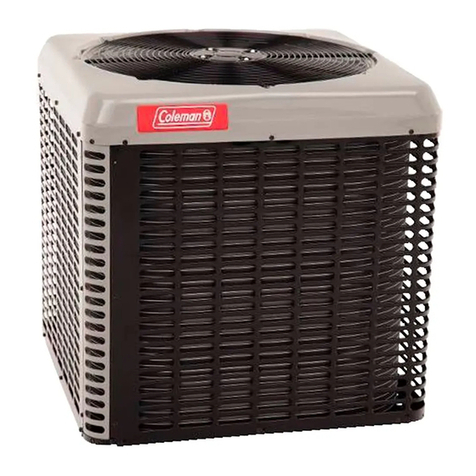
Coleman
Coleman LX SERIES Technical guide

Daikin
Daikin VRV II RXYQ5MY1B Service manual

Ideal Heating
Ideal Heating ECOMOD AHP60 26 kW Installation and servicing

Amana
Amana REMOTE HEAT PUMP installation instructions
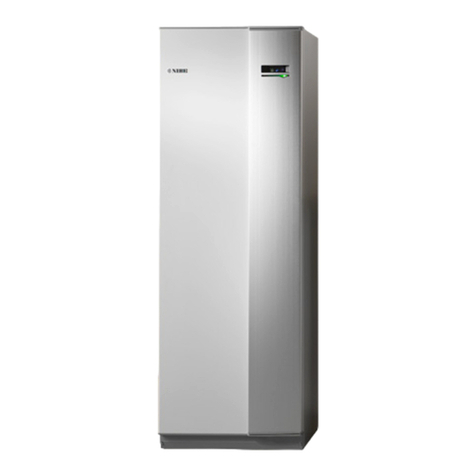
Nibe
Nibe VVM 310 Installer manual

Danfoss
Danfoss DHP-M installation guide

Daikin
Daikin Altherma 3 R F Installer's reference guide

Bosch
Bosch Compress 7001i AW user guide
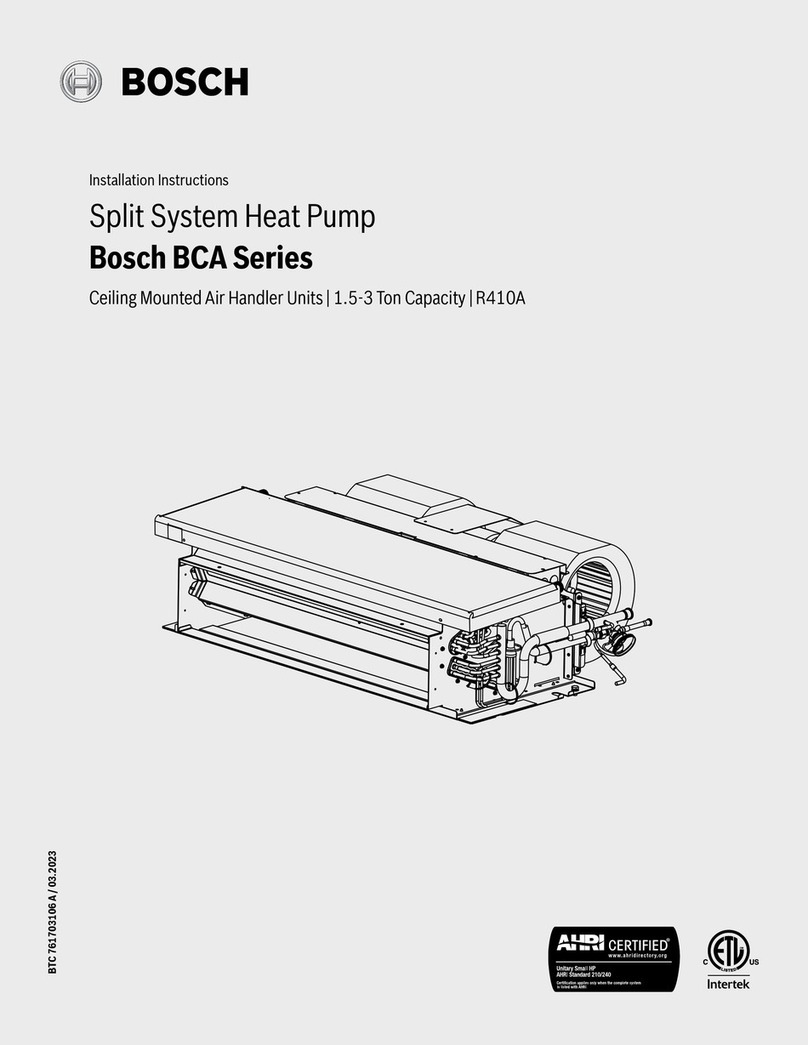
Bosch
Bosch BCA Series installation instructions
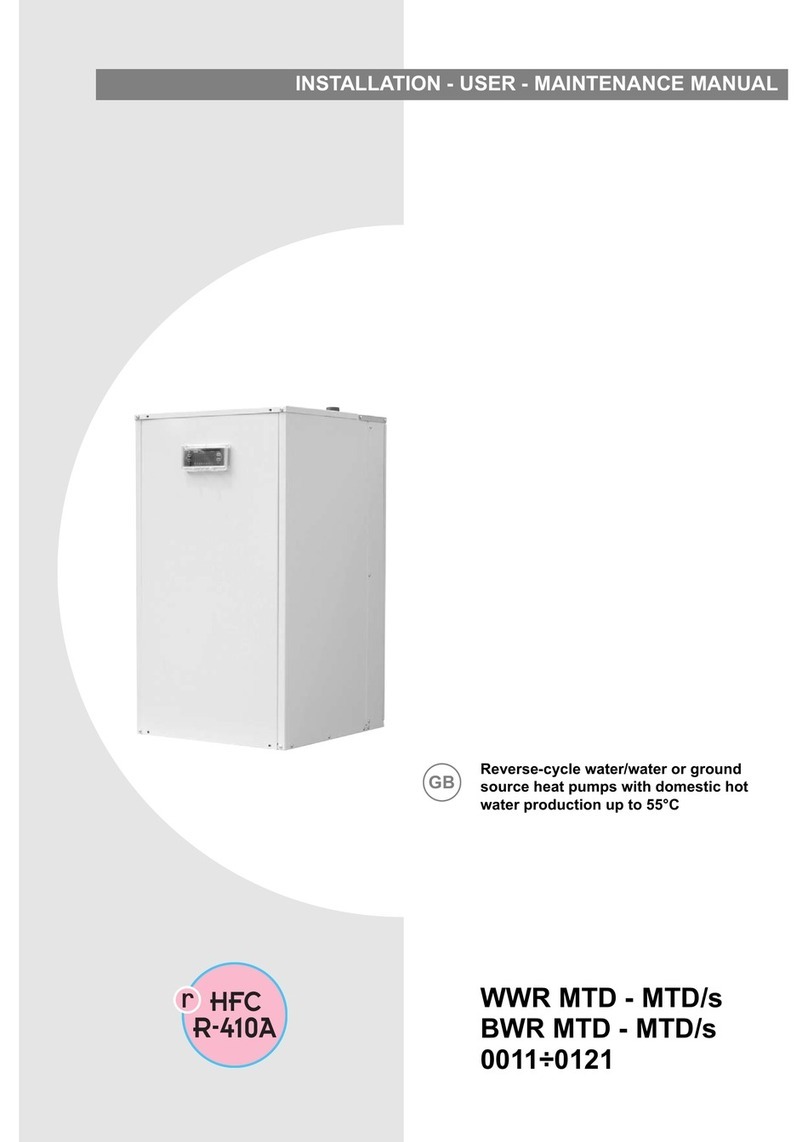
CLIMAVENETA
CLIMAVENETA WWR MTD MTD/s, BWR MTD MTD/s Installation and user manual
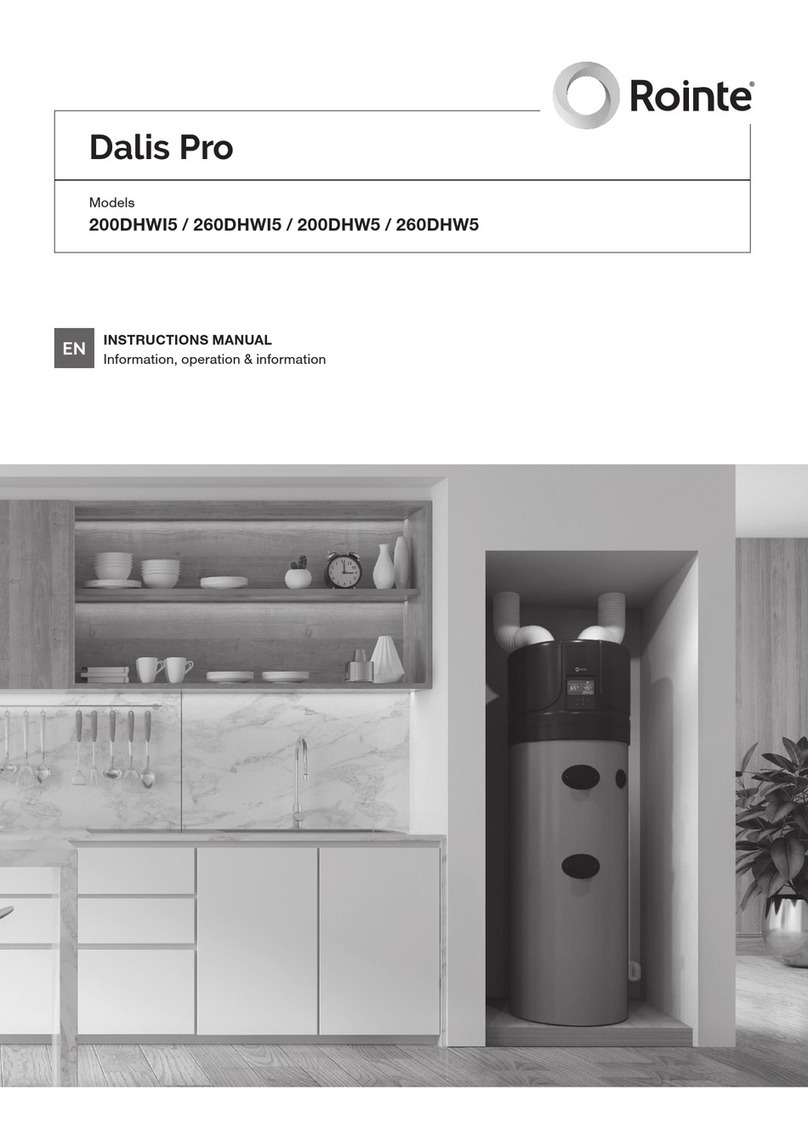
Rointe
Rointe Dalis Pro 200DHWI5 instruction manual
